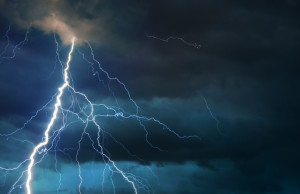Lightning Related Structure Fires
Andrew D. Ellison, CFEI
Timothy Morse, PhD, PE, CFEI
Harri Kytomaa, PhD, PE, CFEI
Exponent, Inc., USA
Presented at International Symposium on Fire Investigation, 2012
ABSTRACT
From 2003-2007 over 4,000 structure fires were caused by lightning annually. These structure fires caused a collective $241 million in damages each year. Lightning is considered a natural fire cause, and can damage both a structure and its contents. This paper will provide a review of lightning-related fires, as well as investigative techniques to utilize when presented with a possible lightning incident.
When lightning discharges to a structure, its energy seeks all available paths to ground. Therefore, lightning damage can be located in multiple apparently unrelated locations throughout a home. These paths often involve continuous conductive systems such as electrical wires, plumbing pipes, and ventilation ducts. As the electrical energy travels to the electrical ground, it can also jump across significant air gaps between adjacent conductors, and break down insulation.
When investigating a fire caused by lightning discharges, it is important that the investigator document the scene thoroughly. Particular attention should be given to metallic or conductive rooftop penetrations (plumbing vents, heating system flue-pipes, chimney caps, etc.) which may have been the point of entry of the lightning strike. Often, such components will demonstrate localized damage consistent with melting or other deformation which is inconsistent with damage from the fire event. Furthermore, the investigator should investigate and document all paths of electrical energy within the home that may exhibit evidence of lightning energy including those that may involve the area(s) of origin of the fire. Paths for lightning energy to ground include branch circuit wiring systems, plumbing systems, metallic structural components, telecommunications wires, etc. These paths typically include the path from the point of entry of lightning to the area of origin as well as the path between the area of origin and the electrical ground of the home.
This paper will discuss the phenomenon of lightning and how lightning energy can enter a home and cause a fire. It also discusses home construction factors that affect the likelihood of a lightning fire. This paper will conclude with some recommended guidelines for fire investigators to consider when investigating an apparent lightning-caused residential fire.



